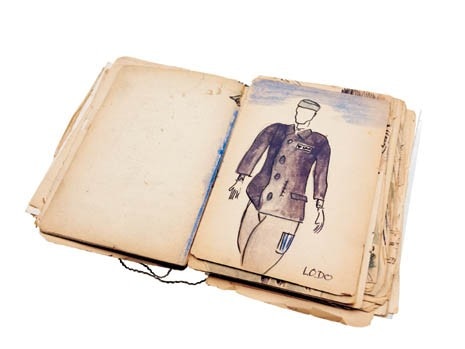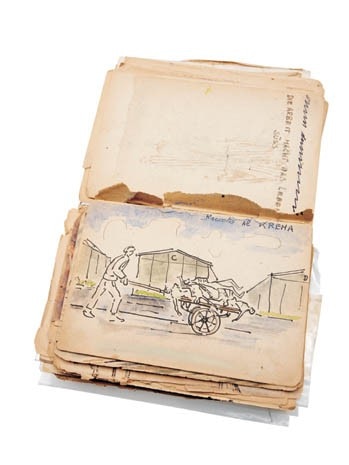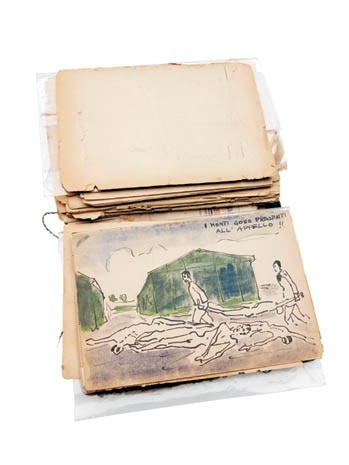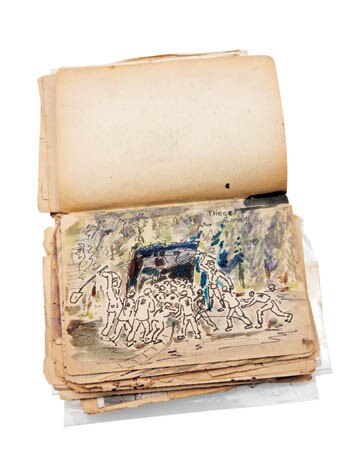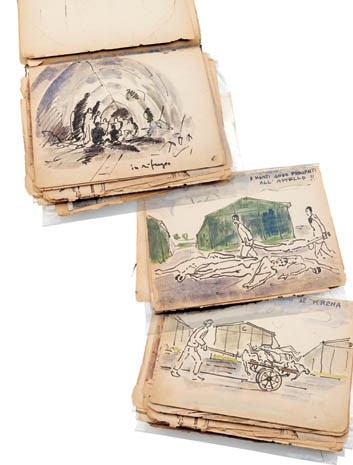Germano Facetti remembers Lodovico Barbiano di Belgiojoso
Germano Facetti was born in Milan in 1926 to a family of artisans. His mother, from a farming family, preferred to skimp on meat to buy him books, preferably illustrated ones with a cloth binding and gilt letters. His grandfather, a sculptor who was an opponent of repetitive work and a lover of craftsmanship, taught him about materials. And in transmitting to Germano his abhorrence of fascism, he taught him to value freedom. His grandfather’s teachings would stay with him for the rest of his life. In 1943, a mere teenager, Germano decided to participate in the resistance and started an information network with Enrico Viganò, hoping to get in touch with resistance fighters. After the first bombings of Milan, he ran into a defecting junior officer and offered him civilian clothes. It was under these circumstances that Germano was given a crate of weapons, which he hid in his house under his bed. On the night of November 4th, the police caught Germano and Enrico in the act of disobeying the curfew while posting placards. Searching their houses, the police found weapons, pamphlets and records of German patrol movements. Suspected of being members of a subversive organisation, they were arrested and harshly tortured - to no avail, seeing as how they had nothing to confess. After several months’ detention in Milan’s San Vittore prison, on the night of February 18th 1944, the two men were brought to the city’s Central Station and loaded on a freight train along with 83 others. After three days of travel in horrendous conditions, the tracks ended in Mauthausen. Aldo Carpi, a Milanese painter and one of Germano’s travel companions, recalls in his journal Diario di Gusen: “The young Germano Facetti used to sing...” Germano was listed as detainee number 53396, and on April 7th, after quarantine, he was transferred to the nearby Gusen 1 camp. Lodovico Barbiano di Belgiojoso arrived in Mauthausen on August 2nd, after six weeks of detention in Milan and three months in the Fossoli camp. He had been arrested on March 21st with his friend and colleague Giangio Banfi for participating in the Partito d’Azione and collaborating with the first groups of partisan fighters. After quarantine, Belgiojoso was transferred to Gusen 1 and Banfi to Gusen 2. They met one last time in the infirmary ward in March 1945. Banfi died on April 10th, less than one month before the arrival of the Americans.
Benedetto Besio: You were imprisoned with Lodovico Belgiojoso. What were the circumstances of your encounter?
Germano Facetti: Lodo arrived at Gusen a few months after I did, in September 1944. He was prisoner number 82266, meaning almost 30,000 prisoners had arrived in those five months.
BB: So you met at Gusen?
GF: Yes. I hadn’t met Lodo before that, even though his family was often mentioned at my house. The Barbiano di Belgiojosos lived less than 50 metres from us, and my father, who was an upholsterer, had often done work for them. After Lodo’s arrival at Gusen, we quickly became the best of friends; it was a strong friendship that would last a lifetime. ww
BB: Belgiojoso was 35 then and already a well-known architect and important figure in Italian culture. Tell me about his attitude towards this abyss that had swallowed you both. What kind of rapport did he have with the other prisoners?
GF: Lodo was extraordinarily courageous and determined to resist, to maintain his dignity unscathed and to preserve his inner freedom. And he was very generous. His profoundly aristocratic character was open to embrace humanity – people in all kinds of conditions. In the evenings, during the few minutes of rest we were permitted, he used to lower his voice, his eyes darting here and there in order to avoid punishment by the guards, and tell us the story of the Sforzas of Milan; he would explain how the Italian Renaissance architects constructed their projects; he would recite Greek lyric poems from memory. He would speak to us of the beautiful, the values of culture; he would free our minds from the daily horrors, allowing us to keep our hope alive. It was the one thing we could use to fight against the cruelty of what was happening to us. He was truly an heir of the great humanists who made a contribution to the best of Italian culture. Very often, he would write poetry, and in moments of precarious quiet he would read them to us. The intensity and strength of his words were often understood even by those inmates among us who did not understand a word of Italian.
BB: You told me that because you worked in the camp’s offices, you were able to come by paper, pencils, pens and coloured paints. Tell me about the little books that you used to make. Were you able to keep them?
GF: Once Lodo asked me to learn some of his poems by heart. His wish was that I should recite them to his children in case he did not survive, for them to remember him by. So on the little bit of paper that I was able to secretly take (running great risks, for one could be killed for any kind of small disobedience), I took to copying down his poetry. Then I would cut the paper with care and sew it into booklets with very short ends of copper wire, which was normally used to attach buttons to our clothes. With this, we who by then had been stripped completely naked before our jailers, once again had something of our own; this restored our feeling of being alive. One of those booklets and some other painful souvenirs I kept in a box used for photographic paper. I called it my “yellow box” and for many years I never showed it to anyone, and even my daughter has never wanted to see it. But now, in my old age and in these dark times of fundamentalism, war and death, I feel the need to speak of these things, so that younger people can understand what we experienced and see what bestiality can come from hatred.
BB: I understand that the yellow box also contains some drawings that Belgiojoso made in the camp.
GF: He drew with the same intent of survival and rebellion against annihilation. His quick sketches illustrated many of the heart-rending scenes that we witnessed. Only once did he make a kind of design for a “house on a hill” for a Polish man. That was in exchange for an extra ration of soup. I tried to imitate him, but my drawings were so much clumsier than his.
BB: You told me that once the Americans had started the liberation, you were able to look for Belgiojoso, who had disappeared from the camp a while before.
GF: Yes, at Gusen there was a rumour that Belgiojoso had been shot or in any case was dead. I was able to borrow an automobile and with a group of Italians we started searching for him in the area around the camp. We found him in the nearby Gunskirchen camp, where he had been transferred at the end of April together with another architect and a building supervisor, both Polish, to design and build a small aqueduct that was to supply the camp with water. We brought him back to Mauthausen with us. A little while later, an ambulance that his family had sent took him back to Milan, along with several others in our group. I remained in the camp for some time and saw him again when I got back to Milan. Our imprisonment was over. In the aftermath, the memories of life in the camp were, as they are for everyone, terrible and frightening, almost preventing me from leading a normal life. But in that hell where violence goes beyond all limits, where men play with the lives of other men, where survival is only for the strongest, I also encountered, especially in Lodo, a kind of humanity that withstands every kind of deprivation and every type of insult, that maintains dignity of mind and hope for redemption through the same culture that has been humiliated by barbarism. In short, Belgiojoso was the one who showed us the way.
BB: What was it like to see each other again in Milan?
GF: For a while after the liberation, I led an irregular and very difficult life. I was without work and without an education. Then Lodo, with his usual generosity, offered me the opportunity to come to the BBPR office to be a draftsman. For example, I was in charge of the building of the model for the Monument to the Dead in the German camps for the Milan cemetery. All the while, Lodo gently nudged me to go back to school, and under the influence of his loving and discreet stimulation, I became interested in many things. For example, I undertook research for Rogers in the Domus archives and in Le Corbusier’s atelier.
BB: I recall that during that period, in 1949, Peressutti was organising the CIAM in Bergamo.
GF: I enthusiastically participated in the Bergamo meetings, for which I worked on the posters. For me those were times of wonderful growth. That was when I met Mary, a young British architect who worked for BBPR. She became my wife, another thing I owe to Lodo.
BB: And then did you leave the BBPR office?
GF: I had become increasingly intolerant of seeing people circulating freely around Milan who had done us so much wrong. So, with the encouragement of Belgiojoso and Rogers, I moved to London where I became a designer. Despite the distance, our friendship remained strong. His courage and uprightness taught me so much. They were an undying source of inspiration for me.
Germano Facetti began work as a designer in London. He enjoyed lengthy employment with the British Olivetti company, designing shops and exhibitions throughout England. He studied design and typography at night at the Central School of Arts and Crafts, becoming increasingly interested in graphic design and publishing. With Theo Crosby, in 1956, he created the exhibition “This is Tomorrow”, an overview that would mark a fundamental point in contemporary European art. He also organised London’s first exhibitions on Italian creativity: “Italian Industrial Design” in 1955, and Italian Contemporary Architecture in 1966. At the same time, Facetti worked on the illustrated books published by Jonathan Cape and other publishing houses. He ended up collaborating with Penguin Books, where he became an art editor from 1960 to 1972, contributing his decidedly innovative approach to the paperback series among other projects. From 1967 to 1969, Facetti was president of the Alliance Graphique Internationale. In 1971, he co-published with Alan Fletcher an illustrated anthology of graphic identity, Identity Kits: A Pictorial Survey of Visual Signals. In 1972, he left London to return to Italy, where he became an editorial consultant and a teacher in Britain and the United States. He now resides in a house set among olive trees on the heights of Sarzana with his beloved Mary. His interest in research and the elaboration of material and memories of a life lived in generosity is still alive. Tall and straight, with penetrating light-coloured eyes that constantly seek connections between things, stories and faces, Germano continues to walk the rocky road that he embarked upon at Gusen with his friend Lodo – a road travelled by someone who has known unspeakable horror but who refuses the concept of hatred.
In queste pagine: poesie di Lodovico Barbiano di Belgiojoso e disegni dello yellow box di Germano Facetti These pages: poems by Lodovico Barbiano di Belgiojoso and drawings from the yellow box by Germano Facetti


